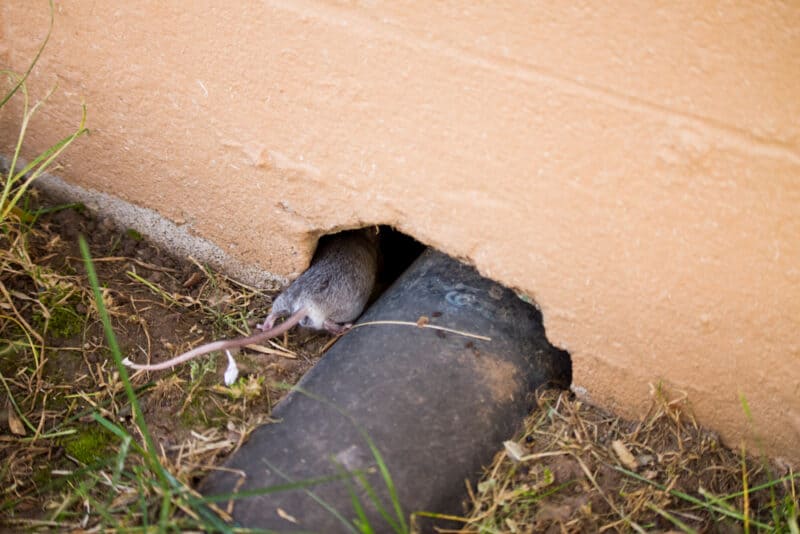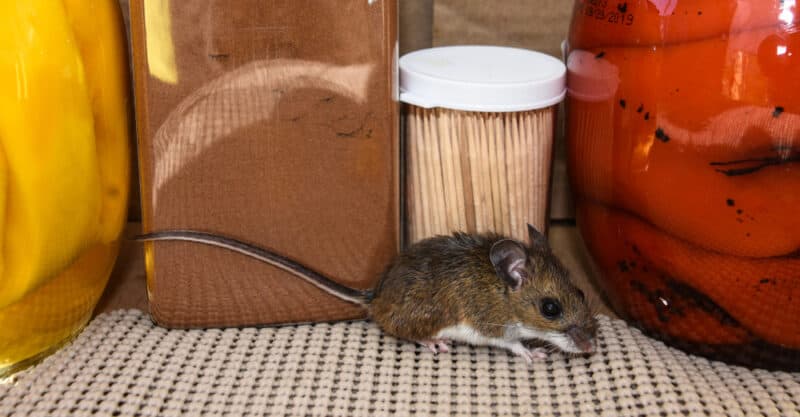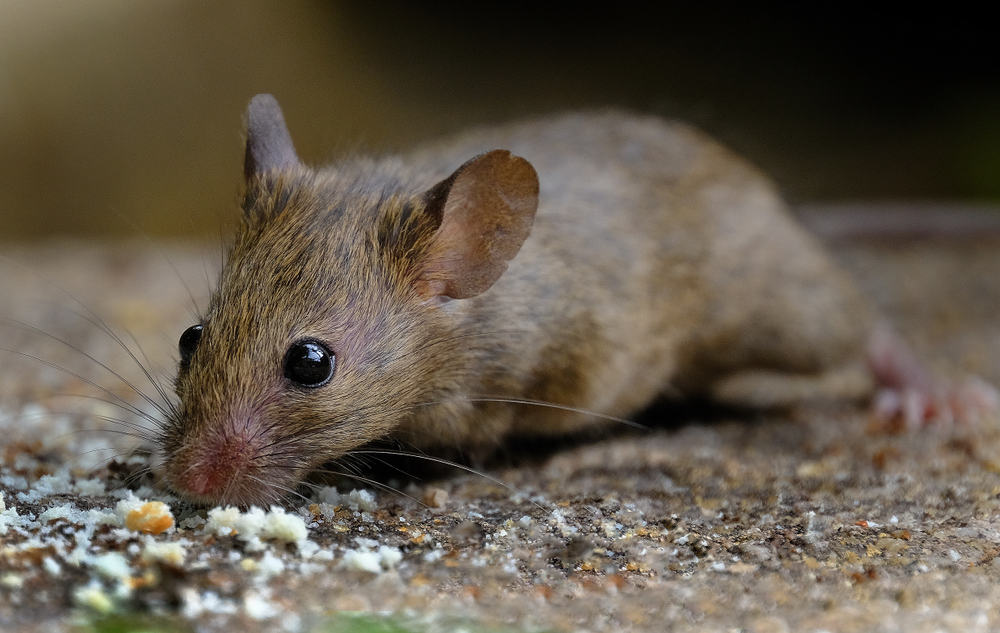There are certain things that are inevitable when you live in a rural environment. One is occasional power failures (if you rely on the grid). Another is having mice in your home. They’re a persistent part of homesteaders’ lives. Fortunately, there are a number of ways to control mice in your home and outbuildings.
The approach you take will depend on your own preferences, as well as just how bad your mouse problem is. These steps work whether you live in the country, the suburbs, or the city.
Why Is It Important to Control Mice Anyway?
For a number of different reasons, actually. One of the main ones is that mice can wreak a thousand shades of havoc on your food stores. You work so hard to grow and preserve a ton of food for the winter months, and perhaps to sell and/or trade with others as well. The last thing you want is for it to get obliterated by tiny little rodent teeth.
Furthermore (and this is a really important second reason), mice can carry a whole host of really nasty diseases. For example, they can carry and transmit the hantavirus via their urine and droppings, as well as hemorrhagic fever, leptospirosis, salmonellosis, and even the plague.
They can also carry pests like antibiotic-resistant bacteria in addition to fleas and ticks.
You do not want these animals anywhere near your food.
Beyond that, they can spread diseases to your pets and livestock, as well. Chickens will even try to eat mice, given the chance.
1. Make Your House Less Appealing to Mice
One of the main reasons mice veer towards certain homes is that they find easy food sources nearby. For example, some people pile their firewood right up against an outside wall. This is basically an ideal mouse condo, especially if you only draw from the woodpile occasionally.
Secondly, keep bird feeders at least 40 feet from the house. Mice, shrews, and other small rodents like to eat the seeds that birds have knocked loose from above. Keep any food sources like these well away from the house, and make sure to keep lids on outdoor garbage cans or food storage bins.
If mice don’t think that your home is an all-you-can-eat snack bar, they’re more likely to keep their distance.
Third, keep trees and bushes close to the house well pruned. Remove lower branches as well as any detritus beneath them. It’s harder for mice to shelter in shrubs that don’t offer them ground-level hiding nooks.
Think of it this way: mice would rather not risk being around humans. They are afraid of us. But if you make your home enticing enough, they’ll chance it. Don’t let your home be appealing enough to attract a little family of mice.
2. Inspect Your Home to Find Where They’re Gaining Egress

Adult mice can squeeze themselves through an opening the size of a nickel, according to the CDC. Basically, if their skull can squeeze through it, so can the rest of them.
As you can imagine, this means that there may be many places in your home where the little blighters can slip through. When we were inspecting our home to try and figure out how mice were getting in, we found a small crack between the house’s wooden framework and the exterior siding. It was about the size of a nickel, but there was enough evidence (mouse droppings) in the area to prove that it was a regular entryway.
You’ll need to inspect the entire exterior of your home to figure out how they’re getting in. Check around door and window frames, beneath exterior siding, and in the gaps where siding meets the foundation. While you’re at it, check to see if there are any cracks in the foundation, or whether ventilation areas have been compromised.
A neighbor discovered that mice were getting into her home via the exterior dryer vent! They’d learned to flip it open and crawl down through the exhaust pipe. These critters can be seriously smart when it comes to finding a reliable meal.
Seal up anything you find by stuffing it thoroughly with steel wool, which mice can’t chew through. You can also use caulking, cement, or hardware cloth.
3. Indoor Deterrents
As mentioned, steel wool is excellent for blocking up any areas where they may be crawling through. Make sure to pack it in very tightly so there aren’t any gaps around it. If at all possible, seal over the hole with spackling, cement putty, or similar.
Make the inside of your home as unappealing and inhospitable to mice as the outside, too. This means ensuring that there are no crumbs or other edible bits left anywhere for convenient snacking. Wipe and sweep away all food remnants and clean your countertops thoroughly. Keep dry goods in glass or thick plastic containers so mice can’t chew through them, and clean up uneaten food around your pets’ feeding areas.
If your stovetop has coil burners, get covers for them—otherwise, mice can crawl through the rings and make a home in the top warming area. Similarly, some like to crawl into the insulated areas between the oven’s walls to get comfy for wintertime.
If you think you have some in there, crank your oven to the highest temperature possible for about an hour. This will send them scurrying elsewhere, at which point you can block off access with the aforementioned steel wool.
Mice also hate the smell of mint, so you can put cotton balls soaked in peppermint essential oil into areas where you think they might be congregating. These animals have extremely sensitive olfactory systems and mint is reportedly overwhelming to their noses. In fact, this is one of the reasons why mint oil has been used to repel and control mice for centuries.
Keep in mind, however, that you’ll have to keep replacing the oil because it fades quickly and the mice will just waltz right past it. You also don’t want to rely on this method alone. Think of it as a helpful addition to your overall plan.
4. Humane Traps
There are a number of different humane traps that you can get, which will capture the mice and hold them without harming them. These range from plastic “catch and release” traps to DIY bucket traps you can rig up in about an hour.
If you go this route, bait your traps with peanut or other nut butter rather than the stereotypical cheese.
Once you’ve caught a mouse, you’ll need to travel quite a distance to re-house it. This is because mice can find their way back home up to five miles from where they came from!
When it comes to re-housing mice humanely, there are a few different steps you’ll need to take.
Tips for Rehoming:
First and foremost, try to catch and release several mice at one go. Mice are incredibly social animals and create strong bonds with extended family members. There’s never just one mouse in a house: it’ll likely have a mate, several offspring, and maybe parents and cousins around too. As a result, try to catch as many family members as you can and release them all together. They’ll find comfort in numbers and will have a greater chance of surviving where relocated.
Release them after sunset in an area that can provide plentiful food, water, and shelter. If you’re releasing mice in autumn or winter, they’ll need a solid food supply as well. The ones you’ve caught have likely spent months amassing enough food to get them through the winter months: without it, they’re likely to starve.
When we relocated several mice that we’d caught, we released them in an abandoned barn several miles away. They got an old wooden birdhouse full of wool roving for shelter, and we left a large pile of seeds for them as well. Remember that these little animals aren’t being purposely malicious: they’re just trying to survive.
Sure, they’re not healthy for humans to share a residence with, but that’s no reason to be cruel to them. If you can relocate them in a way that will ensure their safety and survival, why not do so? If you go this route, make the process as painless as possible for both of you by taking care not to scare or harm your mouse friends.
5. Electronic Rodent Repellents
Another option is to get yourself an electronic mouse and rat repellent. These emit high-frequency ultrasonic waves that small rodents find absolutely unbearable. As a result, they’ll keep as far out of earshot as possible, which means staying well away from your house.
There are a few downsides to these. One is that you’ll need one for every room and have them all on simultaneously for them to work. Another is that mice can become desensitized to these sounds over time, especially if they’re desperate for food.
Furthermore, you can’t use these devices if you have pets such as rabbits, guinea pigs, hamsters, sugar gliders, or other animals that have extremely sensitive hearing. These sounds are torturous to them and can actually kill them. Some dogs and cats can hear them as well. If you don’t have any animal companions and you’d like to control mice in a humane way, try the electronic route in combination with the other deterrents mentioned above.
Again, don’t rely on this method alone. Use it as an additional piece of the mouse-prevention puzzle.
6. Avoid Using Poison
Poison is one of the worst ways to control mice, no matter where you are. Not only is death by poison absolutely excruciating for the animals, but there’s a serious risk to other life around as well. For example, the ASPCA reports over 150,000 accidental pet poisonings from mouse and rat poison every year. And that’s just reported poisonings in the US alone!
These poisons smell appealing to all manner of domestic pets, and it would be devastating to accidentally hurt or kill your companions by spreading this stuff around. Furthermore, cats and dogs that catch and eat poisoned mice often die as well. In fact, if a poisoned mouse gets out of your home and back into the wild before dying, it can kill several other animals as well.
For example, let’s say an owl swoops down and captures that poisoned mouse. It then takes it back to its nest, where it ingests the mouse and then feeds bits of it to its offspring. That poisoned mouse has now killed a few owlets and either severely injured or killed its parent as well. The same goes for other animals that prey on mice such as foxes, various mustelids (like ermines and stoats), and other raptors like hawks, kestrels, and the like.
Please avoid poisons whenever you can.
7. Get a Companion Animal to Help Control Mice

Cats have been ultimate mouse control helpers for thousands of years. These furry friends aren’t just wonderful companions—many of them are spectacular mousers as well. If you and your family members aren’t allergic to cats, consider getting one or two to help control mice in your home, outbuildings, etc.
Alternatively, if you’re allergic to cats (or just don’t like them), ask friends of yours who have feline friends if you can have a bit of their used kitty litter. After their eyebrows raise, you can explain to them that scattering a bit of cat litter in places that mice frequent is great for fending them off. Mice will think that a cat has moved in and will find somewhere else to visit.
Even if you don’t want a cat of your own long-term, consider borrowing a cat from a friend or family member for a little while. Even a short-term stay can reduce your home’s mouse population exponentially. My last cat took out three or four a night until there weren’t any left to hunt.
Ferrets
If you’re allergic to cats (or just don’t like them) but still want to have an animal companion who can help to control mice in your home, you might want to get a ferret instead. These fierce little creatures are magnificently mischievous and are even better mouse hunters than cats, provided that they’re allowed to roam the house freely.
These are considered exotic pets and require special care. Ferrets also have a noticeable musky scent that some people find unpleasant. Those factors considered, they’re excellent companions and can take out errant mice faster than you can blink.
8. Lethal Traps
If everything else has failed and you’re choosing the lethal trap route, please ensure that you get those that are actually lethal. Listening to a poor little mouse scream through its death throes is absolutely heartbreaking.
Skip those horrible glue traps, as they kill mice slowly via starvation and dehydration. Instead, go for very powerful snap traps that are strong enough to kill rats instantly. These will bring a quick end to the mice, without any suffering.
9. Professional Exterminators
If your own efforts to control mice in the house prove ineffective, you may have to call in the big guns, so to speak. Mice can be very wily and creative when it comes to evading traps. Since they breed so prolifically and indiscriminately, having a single pregnant mouse in the house can lead to a full-on infestation within a few months.
Professional exterminators can determine where they’ve been getting in as well as making nests. They might use a variety of different techniques to eliminate the mice, including traps as well as poison. This may not be a fun thing to think about, but it’s effective. Furthermore, it’ll keep the mice from gnawing through power cords and potentially causing fires.
How to Control Mice Long-Term

You’re not going to be able to eliminate all the mice in your home or outbuildings immediately. Furthermore, another generation will inevitably find a way inside. The best thing to do is accept that dealing with mice is an inevitable aspect of rural life. Then you can just make mouse maintenance part of your annual routine.
Check on areas of possible egress regularly to make sure small holes stay blocked up. Do the same thing with chicken coops, barns, and other outbuildings. If barn owls move into larger buildings on your property, let them stay there: they’ll be invaluable in keeping populations down.
When you stay diligent with all of these approaches, you’ll discover that the mouse population dwindles more and more with every passing year. Sure, you’ll get an occasional mouse now and then, but you won’t have an infestation to contend with. Your food stores will stay safe, you won’t be kept awake by pattering mini paws all night, and mouse droppings will be a rare occurrence.












